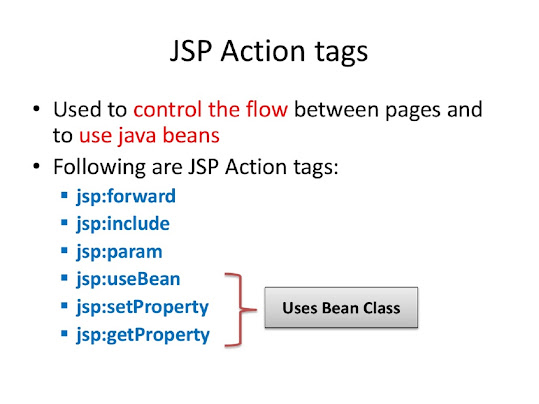JSP provides standard actions to do things without using Java inside the scriptlet. Two of such standard actions, which help JSP to interact with other server resources e.g. another JSP, Servlet, or HTML files are, include and forward actions. The <jsp:forward> action enables you to forward an HTTP request to a static HTML file, a servlet, or another JSP. It has an attribute called page, which accepts the URL of another resource as shown below:
The path to the resource is relative, as the request itself has knowledge of the current URL. Btw, what is the difference between include and forward action is one of the common JSP interview questions, and if you are preparing for Java or JEE developer interviews then you should be aware of many such frequently asked questions.
<jsp:forward page="URL" />Let's say you have two JSP files, hello.jsp and header.jsp in your Java web application, and if you want to forward an HTTP request from hello.jsp to header.jsp, you can add the following lines into hello.jsp:
<jsp:forward page="header.jsp"></jsp:forward>
The path to the resource is relative, as the request itself has knowledge of the current URL. Btw, what is the difference between include and forward action is one of the common JSP interview questions, and if you are preparing for Java or JEE developer interviews then you should be aware of many such frequently asked questions.
One way to prepare well is to refer to a good book like Java Programming Interviews exposed, which contains questions and answers from all important Java topics and frameworks, including Servlet and JSP.
Worth noting is that the JSP that contains the <jsp:forward> action stops processing, clears its buffer, and forwards the request to the target resource. Note that the calling JSP should not write anything to the response prior to the <jsp:forward> action.
Worth noting is that the JSP that contains the <jsp:forward> action stops processing, clears its buffer, and forwards the request to the target resource. Note that the calling JSP should not write anything to the response prior to the <jsp:forward> action.
Anything written would go away and not appear in the final response which comes from the header.jsp now. Remember, include action is different than include directive, which also includes a response from another resource but at translation time, not at the request time.
You can also pass additional parameters to the target resource using the <jsp:param> tag.
In this example, the footer.jsp can access the value of copyright and credit parameter by calling the request.getParameter("copyright").
On the other hand <jsp:include> action is used to load the content of another JSP, Servlet, or HTML file into the current JSP. <jsp:include> also execute the code and force a flush of the buffer in the output stream.
If a.jsp has the code like
then the header.jsp execute and the output is placed in the a.jsp
Here is a full list of supported standard action by JSP, you can also read Head First JSP and Servlet to learn more about Java Server pages:
That's all about difference between <jsp:include> and <jsp:forward> action in JSP. In short include, action is used to include contents of another Servlet, JSP, or HTML files, while the forward action is used to forward the current HTTP request to another Servlet or JSP for further processing. They are exactly similar to include() and forward() method of RequestDispatcher and Servlet.
You can also pass additional parameters to the target resource using the <jsp:param> tag.
<jsp:forward page="footer.jsp" > <jsp:param name="copyright" value="2016" /> <jsp:param name="credit" value="java" /> </jsp:forward>
In this example, the footer.jsp can access the value of copyright and credit parameter by calling the request.getParameter("copyright").
On the other hand <jsp:include> action is used to load the content of another JSP, Servlet, or HTML file into the current JSP. <jsp:include> also execute the code and force a flush of the buffer in the output stream.
If a.jsp has the code like
<jsp:include page="header.jsp" flush="true" > <jsp:param name="key" value="value" /> </jsp:include>
then the header.jsp execute and the output is placed in the a.jsp
Here is a full list of supported standard action by JSP, you can also read Head First JSP and Servlet to learn more about Java Server pages:
That's all about difference between <jsp:include> and <jsp:forward> action in JSP. In short include, action is used to include contents of another Servlet, JSP, or HTML files, while the forward action is used to forward the current HTTP request to another Servlet or JSP for further processing. They are exactly similar to include() and forward() method of RequestDispatcher and Servlet.
Other Servlet and JSP Articles you may like to explore
- What are implicit objects in JSP? Examples
- Difference between include directive and include action in JSP
- How to fix cannot find tag library descriptor error in JSP
- How to escape HTML special characters in JSP?
- Difference between ServletContext and ServltConfig?
- Differnece between HttpServlet and GenericServlet?
- Difference between the include and forward method of RequestDispatcher?
- Difference between forward and sendRedirect in JSP?
- Free Servlet and JSP Courses for Beginners
- 12 Servlet and JSP Interview Questions with Answers
Thanks for reading this article so far. If you found this Servlet and JSP Tutorial useful then please share it with your friends and colleagues. IF you have any questions or feedback then please drop a note.

thank you
ReplyDelete